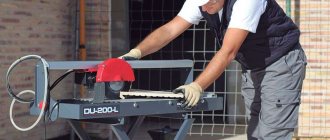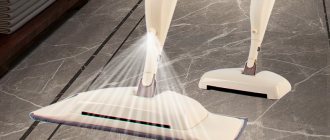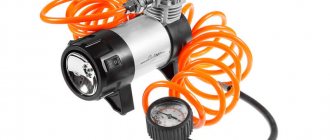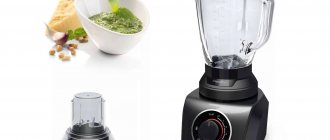Liquid
The most accurate among all magnetic ones is considered to be a liquid compass. In a typical simple version, it looks like a “cauldron” filled with water, in which an aluminum or bronze cartridge is fixed on a vertical axis. There are magnets attached to different sides of the card.
In such devices, the liquid stabilizes the needle; in a stable position, the needle helps to accurately determine the readings.
Tablet
Such a device is presented in the form of a tablet; it contains a round flask with a magnetized arrow. The tablet compass is equipped with a magnifying glass for easy viewing of the scale. A special liquid in the capsule ensures the stability of the arrow during rapid movement.
Basic models
Designed for beginner tourists, they have all the necessary components, but they do not have a mirror or adjustment of deviations.
Multifunctional
They are equipped with a mirror, magnifying glass and other additional features. Suitable for regular hikes in the outback, away from the routes.
Tips for choosing
Choosing a suitable compass is actually not that difficult, but you need to know certain secrets and features. Adviсe:
- It is important to decide on the method of movement in which the compass will be used.
- If you are planning a hiking trip, then you should pay attention to the classic models with a magnetic needle. They have a ruler and degree division. Due to this, degree calculations and azimuth calculations are simplified.
- For cycling trips, you should opt for GPS models, but you need to take spare batteries with you. Plus, take the classic model as a spare.
- For pilots, regardless of the type of vessel - airplane or helicopter, it is worth choosing an electronic compass. This one has many additional functions, for example, they help determine pressure and altitude.
- If you decide to buy a mechanical model, you should check the compass for accuracy. It's not difficult to do. You need to place it on a flat surface and wait until the arrow freezes. After this, bring a metal object, wait until the arrow deviates towards it and remove this object. If the device is of high quality, the needle will return to its original position without error. It is worth repeating the described experiment several times to ensure the accuracy of the compass.
- When choosing a different type of compass, it is worth getting qualified advice from the seller.
Magnetic
There are several types of devices with which you can determine cardinal directions.
Mechanical
It can be an ordinary tourist one. This type of compass has a red-tipped needle on a needle pointing north, where the magnetic field is strongest. With a simple magnetic device together with a map, you can more accurately determine the location of various objects.
For the military
It differs from the usual one by a magnifying lens and a sighting device. With such a device, you can more accurately determine the direction of the path in the field.
Geological
In this device, the direction scale divisions are located counterclockwise. To determine the angles of incidence of rock layers, it is equipped with a clinometer and a half-limb.
Hygroscopic
A hygroscopic compass is installed on airplanes and river vessels. It is equipped with a gyroscope, thanks to this device, it points to the true pole, and not to the magnetic pole. This device is stable, so it shows the direction more accurately during swinging.
Astronomical
This view allows you to determine the cardinal directions based on the stars and luminaries. The disadvantage of the device is that it cannot be used during the day.
For orienteering
Which compass should athletes choose? They must be able to use a magnetic compass and understand a topographic map.
Therefore, an orienteering compass must have high performance characteristics, such as:
- speed and speed of installation of the magnetic needle;
- stability of the arrow during rapid movement of athletes;
- ease of use so that the device is held steadily in the hand;
- small size and light weight.
Kinds
There are several types of compass designs. But at the same time, any of them determines the direction of the world. Additional features include calculating the angle and a number of other actions.
There is a division into the following large categories:
- Mechanical compasses. These have a metal magnetized pointer; it is she who is stubbornly moving towards the north direction.
- Electronic compasses. They don't have arrows, but they do have a screen, a processor, and a number of other electronic components. The main information on the screen is the direction of the light, plus other additional information can be displayed on it.
Classification by type of use goes to:
- Tourist. They are easily recognized by their round body in the center of which a magnetized arrow rotates, pointing north. Along the contour of the box are numbers and degrees of azimuth. There may be a special liquid inside such a compass. Also available with or without sealing. This kind of tourist compasses differ in size, color, and additional attributes. So a thermometer or some kind of sensor can be embedded in its strap.
- Military. It is somewhat similar to a tourist one. But it has a number of additional accessories - a ruler, a sight, a magnifying lens. It is often made in a metal case, which makes it more reliable. It is also more accurate than the tourist one.
- Geological. Here the markings go counterclockwise. Plus, the device has a half-limb, a clinometer. These functional components help in calculating layer angles.
- Astronomical. It helps to find cardinal directions based on the location of stars and luminaries. It is accurate, but only works at night, when the stars are actually visible. It is impossible to use it during the day.
- Gyroscopic. There is a gyroscope at its base. Due to this, the arrow can be directed to the real pole rather than to the magnetic one. The accuracy of such a device is higher, so it is often used on ships and aircraft.
- A compass is a kind of geodetic compass. With its help, you can find the angle of incidence while shooting on location. Sometimes it is used in military affairs for artillery guidance and direct fire.
Types of electronic compass:
- Radio compass. It points to any object emitting radio waves. It could be a radio beacon. This feature is used in aviation. A radio compass comes to the rescue when spatial orientation is needed during flight.
- For a travel electronic device, the main change concerned the arrow; it is not here. This compass operates entirely electronically. The cardinal directions themselves are determined by the magnetic attraction created by the electrical circuit. In addition to this, such a device has various programs that make it possible to find out the time. You can even watch movies on some devices.
- Compasses with GPS systems or Glonas. Their electronic filling helps determine the direction of the world using satellites. Such devices are the most accurate and with their help it is possible to determine the location of a person. But its peculiarity is that you need to receive a signal from 3 satellites at once.
Electronic compasses
Electronic compasses operate on the basis of magnesium sensors, and are included in the satellite navigation system when searching for the desired coordinates. They are intended only for professionals; they are used mainly by military personnel and representatives of law enforcement agencies.
Depending on the location and purpose, these types of electronic navigators are used.
Radio compass
Indicates the direction of an object emitting radio waves. It is used by aviators to navigate in space during flights.
Travel electronic compass
It differs from a mechanical tourist one in that it does not have a magnetized pointer. The compass determines the cardinal directions using electronic circuits. It shows the time and has various additional programs built into it, even videos.
GPS and GLONASS
These navigators operate using an electronic system; they receive signals from several satellites to determine the exact location and direction.
GPS receivers are considered high quality navigators and are almost always equipped with an electronic compass. But GPS navigators cannot work without a battery, which can run out at the most necessary moment. Therefore, during a hike you cannot do without a magnetic compass or a set of spare batteries.
GPS receivers, unlike magnetic compasses, have the following advantage: they can estimate the current location without visible landmarks on snowy days and in foggy weather. With a GPS device, you can easily set the desired direction when avoiding an obstacle and re-adjust the compass along the changed route line.
Satellite compass
A satellite compass works by receiving signals from satellites. Such a device shows the direction to the true poles, that is, to the geographic north and geographic south.
Such a compass will not work indoors or underground, which limits its scope of application.
The readings of this compass do not depend on magnetic anomalies and deviations, however, it will not work if the satellite signal disappears or the power supply runs out. These are the devices that are built into modern phones and smartphones, and on the same iPhone, the compass works by receiving signals from satellites and indicating directions to different sides of the world. Most smartphones initially have a built-in GPS receiver to expand its functionality, and when receiving data on the phone’s location, it is very easy to indicate directions to the cardinal points.
Criterias of choice
The choice of compass depends on the purpose: you buy it for hunting, for hiking or orienteering. It is recommended to choose a compass model so that it can be used in different situations: during hiking trips and orienteering competitions.
What is the best compass for hikers and bikers?
When choosing, you need to take note of some nuances:
- Classic models of compasses with degree division and with a ruler are suitable for hiking trips.
- Tourists often use degree calculations and azimuth calculations, so they need a ruler and a degree dial on the compass when hiking.
- For cyclists, a more acceptable option is a GPS navigator, although its batteries run out quickly. Therefore, cyclists will have to take a classic compass with them.
- For air travel, preference should be given to electronic navigators, since they are multifunctional and you can use them to determine both altitude and pressure.
COMPASS
A compass is not needed in all types of orienteering, but is a symbol of this sport.
In the era of GPS navigators, tourists may be tempted to abandon the use of a map and compass. However, it is important to understand that a GPS receiver cannot completely replace them because it requires constantly having charged batteries. To do this, you have to take several sets with you, and all this affects the overall weight and volume that you carry on your shoulders.
This is interesting: How to navigate a map using a compass
Even if you are well oriented in a certain area and can calmly walk in azimuth, a compass will help you determine your position on the map to ensure that you are heading in the correct direction.
Compasses are as follows:
- With floating magnetized needle
- Digital
Compasses with a floating magnetized needle
When choosing a compass, first answer one question: why do you need it? For what level of competition difficulty?
Compasses can be divided according to their purpose:
1. Setting the distance, orienteering, travel, tourism
2. Professional orienteering
3. Keychain – some types of keychains show the north well. But still they serve more for entertainment than for navigation.
4. Other types that relate to speleology, yachting and other sports.
When choosing a compass, you should pay attention to the following design features :
COMPASS CAPSULE:
– Normal (air inside).
– Liquid (either oil or kerosene is used inside, which stabilize the needle, which makes it possible to obtain more accurate readings). This compass can be used while walking.
At high altitudes or low temperatures, a bubble may form in the liquid capsule. This will not affect accuracy. The bubbles disappear when the compass returns to normal conditions.
Both types of compasses must be held horizontally.
ROTATING BEZEL (or azimuth ring):
- The price of dividing a degree measure - pay attention to how well the lines are readable, because When running, visual acuity decreases, especially if you use a compass at night. A circle is divided into 360 degrees. In simple compasses, the division price is 5 degrees, in more advanced ones (average price range) - 2-2.5 degrees, and in professional compasses - 1 degree. A mid-price compass has an accuracy of up to 2-2.5 degrees, more expensive ones have a smaller error (professional - up to 1.5 degrees).
- Some compasses have a luminescent coating on the bezel, allowing it to collect light from a flashlight and glow at night.
ARROW:
- The quality of magnetization, material - the sensitivity depends on them, how quickly and accurately it stops.
- Shape – if the arrow is wide, it is better visible (which is important for people with poor eyesight).
- Some arrows may have sapphire, agate, or other types of axle support, which also affect accuracy.
AUXILIARY ELEMENTS of the compass:
- Magnifying glass – convenient for viewing local elements on the map.
- Ruler cm/inches.
- Scale bar.
- Lanyard for holding.
- Aiming Mirror: Helps you aim more accurately. This device can also serve as an emergency warning device or a personal mirror.
This is interesting: Why are mountainous areas indicated separately on the map?
Digital compasses
Such compasses are easier to read. However, they require calibration and are battery powered, so they are less reliable than traditional floating needle compasses. It is important to always have spare batteries with you.
When orienteering at night, a flashlight is a must.
Review of the best models
Good quality equipment for tourists is produced by the Swedish company Silva and the Finnish company Suunto.
Silva 6 Nor Spectra
Suitable for use on any terrain, it is a classic professional device for orienteering, equipped with the Spectra system, the arrow of the device is straight and wide, convenient for quickly reading readings.
Differs in the following features:
- With a strong magnet, the instrument needle quickly calms down.
- Clear base plate with clear markings
- Safe to place in your hand.
- The Silva 6 Nor Spectra Right can also be held in the right hand.
Suunto M-9
The Suunto M-9 wrist model is convenient and multifunctional.
Tourists choose it for its small size and light weight, as well as the accuracy of determining the direction. The wrist device can also be used underwater.
Brunton International Pocket Transit 0-360 Degree
A good American-made device is considered the most reliable and suitable for use in field conditions.
The aluminum body is particularly durable and waterproof. The device is characterized by increased accuracy of direction determination.
How to choose the right compass
One of the most important criteria is the size of the device. In camping conditions, a bulky device will become a heavy burden. The compass should not cause inconvenience due to its dimensions. Therefore, it is preferable to choose compact models. Ideally, the compass fits in the palm of your hand. At the same time, it must be waterproof and durable. After all, tourists during hikes or competitions are far from being in greenhouse conditions.
If you know in advance in what situations the device will be used, then it will become clear how to choose it. For orienteering in the forest, when a compass becomes the only way to determine your location, it is better to take an electronic view. Such devices show not only cardinal directions, but also exact coordinates. To be on the safe side, a liquid or magnetic compass is suitable. If you are planning a hike, including at night, it is better to take illuminated compasses. When traveling on an ATV, snowmobile or bicycle, a built-in navigator, which is often equipped with electronic compasses, would be useful.
Some models include instruments such as a barometer and altimeter. They are very useful on long hikes, especially in the mountains. Thanks to the readings of the barometer, which measures atmospheric pressure, it is possible to predict weather conditions. If the pressure suddenly drops, then rain or thunderstorms are coming. When the pressure remains high for a while, clear weather is expected. The altimeter shows the altitude above sea level. When hiking or horseback riding in mountainous areas, you can control the height to which you managed to climb in a given period of time.
Experts advise that in order to choose a good compass, take only those companies that produce exclusively navigation devices. Such devices will be accurate and durable if used correctly. Beginning tourists should not immediately spend money on super-expensive models. In the forest they can easily be lost or broken. Then, when you manage to get acquainted with the intricacies of camp life, the time will come to think about a more advanced compass.
How to navigate with a compass
So what you need to do:
- First you need to determine a landmark to which you should return, for example, it could be a tree.
- Orientation begins by pressing a special lock and releasing the magnetic needle.
- Taking the device and placing it horizontally on your palm, you need to wait for the blue arrow to position at 0 degrees of the scale, then turn the lid to install it with the slot towards you and the front sight towards the object.
- Having chosen the direction of movement, you should fix it and remember the value of the angle, called “azimuth”.
- Constantly checking the direction, you need to start moving.
- After you have reached the final point of movement, you should turn around your axis. This means that a rotation was made around its axis by 180 degrees. It turns out that we returned to the starting point of the route.
Tourists and travelers, as well as hunters, can find themselves in unfamiliar places at any moment and lose the direction of their further movement. In such cases, a compass can quickly determine the location.
But before choosing a compass, you need to study their types, properties, as well as for whom and for what purposes they are intended.
Does a magnetic compass work outside of Earth?
Many stars, planets and their satellites have a magnetic field, but often the magnetic field is so weak that it cannot affect the needle of a magnetic compass. More sensitive instruments detect even such an insignificant manifestation of magnetism, but now we are not talking about them.
For example, on the Moon, it is most likely impossible to use a magnetic compass for orientation, since the Moon’s magnetic field is very weak.
The same applies to outer space at a great distance from celestial bodies. Here the magnetic fields, as a rule, are so small that they are not able to move the needle of the magnetic compass from its place.
The last statement is true only for a magnetic compass located far from a spaceship roaming the expanses of space. On the ISS, compass readings will depend entirely on magnetic deviations caused solely by parts of the space station itself.
On the other hand, we should not forget that even on those planets where the magnetic field is no less, or even greater, than on Earth, the magnetic poles periodically change places, and the direction to the magnetic pole will most likely not coincide with the direction to the geographic pole . In principle, as mentioned earlier, the Earth has the same “trouble”, and the fact that today we have the opportunity to use a magnetic compass to approximately determine the direction to the geographic poles is, one might say, just a happy coincidence.
Thus, speaking about a magnetic compass as the main means of navigation for a tourist, one must always remember about the limitations in its operation, which, fortunately, are not many. In most cases, a magnetic compass, when used correctly, will help people find their way in space; if they have a map, they will help determine their location, as well as find the direction for further movement, including in order to quickly reach people in an emergency.
If in an emergency situation a person does not have a navigator, a compass, or metal objects from which one could be made, then all that remains is to navigate using the so-called solar compass - a gnomon.
Author: Maxim Chechetov










